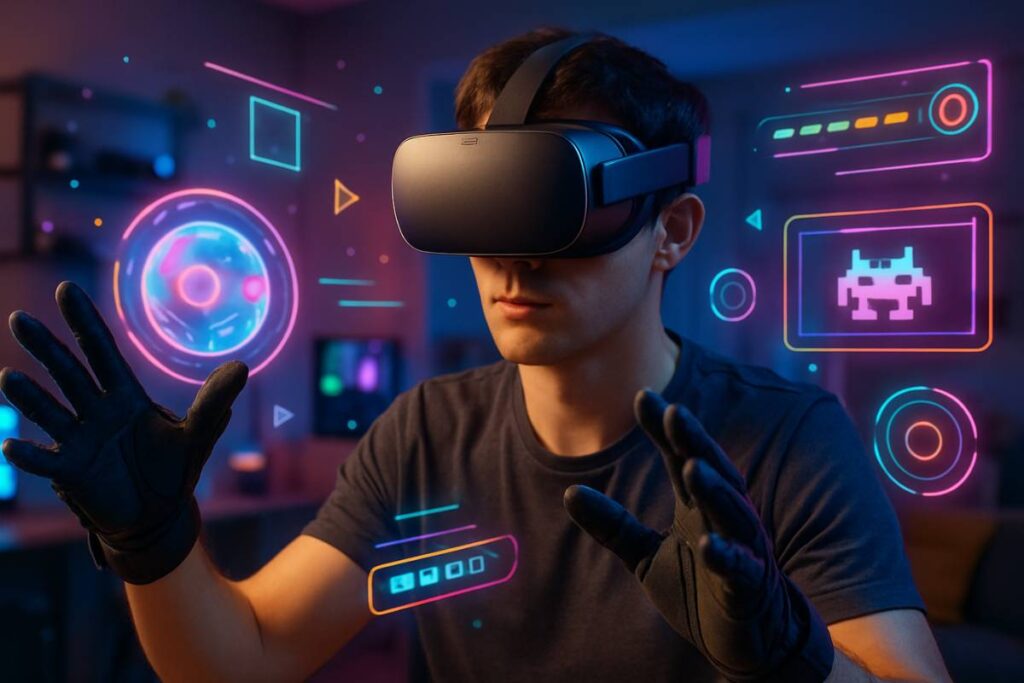Gaming has changed a lot since characters with pixels jumped around on 2D screens. But nothing, absolutely nothing, has caused as much disagreement as virtual reality gaming.
Is it a big deal? A passing trend? Or something in the middle?
The truth is that it’s not easy. VR gaming is at this interesting crossroads where cutting-edge technology meets human psychology, and billion-dollar investments clash with the limits of the real world. And to be honest, whether it’s a gimmick or the future depends on who you ask.
The Numbers Don’t Lie: VR Gaming Is Growing at an Amazing Rate
First, let’s talk about the facts.
The VR gaming market is growing so quickly that any tech investor would be shocked.
The size of the market says a lot:
- 2024: $32.5 billion around the world
- By 2025, it is expected to be worth $35.49 billion
- 2030: Expected to reach an incredible $85.45 billion
From 2025 to 2030, that means a compound annual growth rate of 21.6%. To put that in context, those numbers would be great for traditional console gaming.
But here’s the most interesting part: the Asia-Pacific region is leading the way with a huge 23% CAGR. Not only are China, Japan, and South Korea adopting VR, but they’re also changing the way we think about it.
Why VR Gaming Is Finally Taking Off
Hardware Revolution: Say Goodbye to Heavy Headsets
Do you remember the first VR headsets? It was like putting a microwave on your face. Not exactly… at ease.
The hardware of today tells a different story. We’re seeing lighter designs, have wireless capabilities, and have much better resolution. Companies are making headsets that feel more like wearing glasses than carrying gear.
Some of the most important changes are:

- Wireless technology: No more tripping over cords while playing hard games
- Better displays: Images that are high-resolution and look real
- Lower latency: In some 5G setups, the time it takes for motion to turn into light drops below 10 milliseconds
- Eye tracking: This makes foveated rendering possible, which speeds up graphics processing
The Problem with the Content Is Fixing Itself
Early VR had what I call the “demo syndrome”: a lot of cool 10-minute experiences but not much real content. That is changing quickly.
AAA game studios are now putting a lot of money into games that are only available in VR. Instead of short tech demos, we’re seeing campaign games that last 20 hours. “Half-Life: Alyx” showed that VR could give you a deep story and immersive gameplay at the same time.
According to the gaming industry, about 70% of people who use VR play games on a regular basis. That gives you a good base for long-term growth.
The Gimmick Side: Real Problems That Can’t Be Ignored
But let’s be honest about the issues. There are some big problems with VR gaming that go beyond the technical side.
Motion Sickness: The Death of Fun
Here’s an uncomfortable truth: motion sickness is still a huge problem. Some types of VR games have refund rates higher than 25%. That’s not good for business.
The average VR gaming session lasts about 45 minutes, which is much shorter than the average console gaming session. If people can’t play for long periods of time without feeling sick, there’s a basic problem with the experience.
The Problem with the Price Tag
Even though VR gaming has gotten better, it still costs a lot of money. It doesn’t take long for the costs of high-quality headsets, powerful PCs, and accessories that work with them to add up. There are cheaper options for beginners, but the best VR experience is still expensive.
This makes what researchers call a “two-speed market,” with budget options that don’t have as many comfort features and premium devices that most people can’t afford.
Space Needs
Not everyone has enough space for room-scale VR. Urban living spaces, apartment rules, and safety concerns make it hard to adopt. That’s one reason why location-based VR arcades are doing well in crowded Asian cities: they solve the problem of not having enough space by giving people their own places to play.
The New Technology That’s Changing Everything
5G and Cloud Gaming Are the Game Changers
This is where things start to get really interesting. 5G networks and edge computing are getting rid of VR’s biggest technical problems.
Cloud-based VR gaming lets high-end graphics processing happen on a remote server, so users don’t need to buy expensive hardware. Telecom companies in South Korea and the Nordic countries are putting together 5G plans with cloud-rendered VR subscriptions.
The effect is big:
- Needs less hardware
- Lower costs to get in
- Access to premium content on mid-range devices
- No more long downloads
AI Integration: Gaming That Is Smarter and More Personal
AI is changing VR gaming in ways that sound like they came from a science fiction movie. AI-powered NPCs now change how they act based on how players act, giving each player a different experience.
AI-powered procedural generation makes game worlds that are always changing and never-ending. Think about settings that change in real time based on how you play, how you feel, and what you like.
Haptic Feedback: More Than Just Sight and Sound
The next big thing is haptic feedback for the whole body. TeslaSuit and HaptX are two companies making gloves and suits that let players feel virtual objects.
Think about going to an alien world where you can touch rocks, feel the heat of a virtual fire, or pick up a digital sword. That level of immersion takes VR gaming to a whole new level.
The Change in Social Gaming
VR is changing gaming from something you do alone to something you do with others. Friends can meet in virtual spaces, work together on challenges, and build communities in multiplayer VR worlds.
Social VR trends include:
- Virtual meetups: Friends getting together in digital spaces
- Collaborative gameplay: Working together to solve problems
- User-generated content: Players making and sharing experiences
- Cross-platform connectivity: The ability to use different VR devices without any problems
This social aspect fixes one of the problems with traditional gaming: the fact that it can be isolating.
Differences Between Regions: A Story of Three Markets
North America: The Place Where People First Use New Technology
North America makes the most money from VR games because people there have a lot of extra money and are quick to adopt new technology. There is a lot of demand in the area for AAA VR exclusives and high-end hardware.
Main Features:
- Focus on high-end home setups
- Strong console integration (partnerships with PlayStation VR and Xbox)
- Focus on deals for exclusive content
Asia-Pacific: The Lab for New Ideas
Asia-Pacific is the fastest-growing VR gaming market, but for different reasons. Location-based VR arcades are growing because there are a lot of people living in cities and not enough space in their homes.
Japan and other countries are building VR-themed cafes where people can eat, drink, and play games at the same time. The Chinese government is encouraging tech companies and schools to work together by supporting technological progress.
Europe: The Market That Values Privacy
The way Europe does things puts a lot of emphasis on user privacy and story-driven experiences. In France and Germany, government money helps creative VR development, and strict rules about data protection help people trust the companies that make VR.
What Experts Are Saying About Industry Predictions
The XR Association says that immersive technology could have a $5 trillion effect on the economy by 2030. It’s not just gaming; it also includes training, education, and business apps.
Key predictions include:
- Standalone headsets are growing at a 29.90% CAGR, which will make it harder for PCs to stay on top
- The software segment is growing at a rate of 24.80% per year as subscription models become more popular
- Commercial applications are growing at a 33.00% CAGR as more and more businesses use VR for training
The Decision: Evolution, Not Revolution
Is VR gaming just a fad or the future?
The answer is both and neither.
There won’t be any time soon when VR gaming takes over traditional gaming. For most types of games and people, console and PC gaming will continue to be the most popular. But VR is finding its own important niche that is growing quickly and solving real problems.
What we’re seeing is specialization instead of replacement:
- VR is better for immersive experiences, social interaction, fitness gaming, simulation, and training
- Traditional gaming is still better for complex strategy games, competitive esports, long narrative campaigns, and casual mobile gaming
In the future, people will probably live together instead of competing. VR gaming is becoming the “specialized tool” of the gaming world. It’s great for certain things, but not for everything.
The Way Forward
Several things will affect the future of VR gaming:
- Technology needs to continue improving in three key areas: reducing the incidence of motion sickness, lowering costs, and enhancing comfort. The industry is improving, but these issues persist.
- Content development should focus on experiences that really benefit from VR, not just traditional games that have been awkwardly changed to work with headsets.
- Teaching the market is very important; people need to know what VR gaming has that regular gaming doesn’t.
The Bottom Line
VR gaming is no longer just a gimmick. The market numbers, technological advances, and wide range of uses show that it will last for a long time. It hasn’t yet become the “future of entertainment” for everyone, though.
Instead, VR gaming is becoming a strong and growing part of the gaming world. For some kinds of experiences, like immersive worlds, social gaming, fitness apps, and specialized training, it’s the future.
For gamers, the question isn’t whether to play VR or regular games; it’s which experiences are best on each platform. And more and more, that’s a fun choice to make.
The argument about the gimmick is over. The future of VR gaming isn’t about replacing everything else; it’s about doing some things better than anyone ever thought possible. And in that regard, it is doing very well.
















